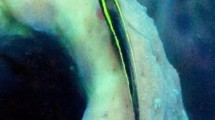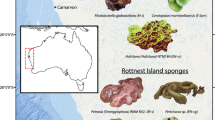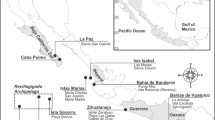Abstract
In this study eight different species of barnacles were found within nine species of sponges from the Red Sea. This brings to 11 the number of sponge-symbiotic barnacles reported from the Red Sea, two of these are new Acasta species (not described herein) and one (A. tzetlini Kolbasov) is a new record for this sea. This number is much higher than that of symbiotic barnacles found within sponges from either the N. Atlantic (2) or the Mediterranean (4). Two possible explanations for this are the presence of numerous predators in coral reefs and scarcity of available substrate for settlement. These factors can lead to high incidence of symbiotic relationships. Of the nine sponge species, only one (Suberites cf. clavatus) had previously been known to contain barnacles. Even at the family level, this is the first record of symbiotic barnacles in two out of the seven sponge families (Latrunculiidae, Theonellidae). Our present findings strengthen the apparent rule that the wider the openings in a barnacle shell, the fewer the host taxa with which it will associate, usually from one or two closely related families, and the more frequent it will associate with elastic sponges. Most Neoacasta laevigata found on Carteriospongia foliascens were located on the same side as the sponge's ostia, i.e. facing the incoming water. This adaptation allows the barnacles to catch more suspended particles from the water, provides them with more oxygen and prevents their exposure to discharged sponge waste. The highest density of barnacles observed on one face of a “leaf ” (with ostia) was 0.389 barnacles cm−2 (one barnacle per 2.57 cm2) and on average 0.181 ± 0.68, while the average on the other side was only 0.068 ± 0.52 barnacles cm−2. As indicated by the Morisita index, these barnacles most frequently (58%, n = 12) had a clumped spatial distribution (while the rest were randomly distributed), as is to be expected from such sessile organisms with internal fertilization via copulation. The presence of N. laevigata induced the growth of secondary perpendicular projections of its host C. foliascens. Of the N. laevigata examined, 17% brooded 324 ± 41 embryos each, of 286 ± 17 μm total length; only 5.7% (n = 123) were found to be dead. Size distribution analysis of skeletal elements from dead barnacles showed them to be significantly larger than the skeletal elements of the population of live barnacles ( p < 0.05).
Similar content being viewed by others
Author information
Authors and Affiliations
Additional information
Received: 26 June 1998 / Accepted: 1 December 1998
Rights and permissions
About this article
Cite this article
Ilan, M., Loya, Y., Kolbasov, G. et al. Sponge-inhabiting barnacles on Red Sea coral reefs. Marine Biology 133, 709–716 (1999). https://doi.org/10.1007/s002270050512
Issue Date:
DOI: https://doi.org/10.1007/s002270050512




